Your First EV Could Be A Cargo E-Bike
Published September 21, 2024
If you’ve been watching the news or your local roads, you’ve probably been seeing all sorts of electric vehicles out and about town. There’s the iconic Tesla Model 3 and Model Y, retro futuristic vehicles from Hyundai like Ionic 5 and 6, the city friendly Chevy Bolt (my personal favorite). But I got an electric vehicle recently that might not be what you think of first when you hear the term EV - a cargo e-bike. And for lots of folks living in urban or suburban areas, I want to show you how you could use it to replace most of your car trips, and save a boat-load of money.
What I’ll Cover
-
What cargo e-bike I got, my experiences with it, and the pros and cons of a cargo e-bike
-
The costs of an e-bike over a year compared to a car
-
Some tips and tricks for living without a car
-
And lastly, some suggestions for cargo e-bikes
My New E-Bike: The Small But Strong Tern HSD
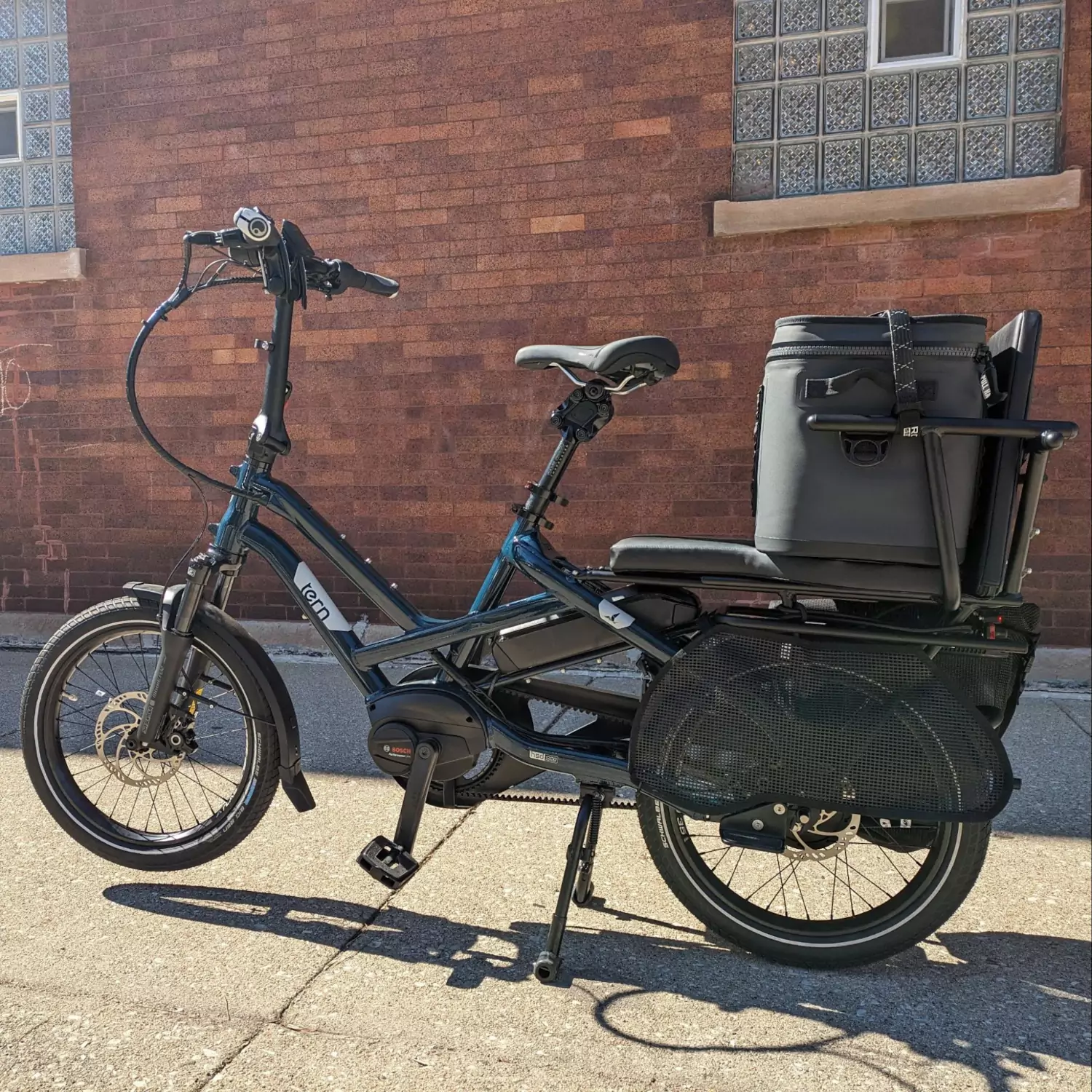
I picked up a Tern HSD Gen 2, which is a type of e-bike known as a long-tail, because it’s longer at the back. It’s also a Class 1 e-bike, meaning it’s limited to a top speed of 20 miles per hour and is pedal assist only - there’s no throttle! I chose this particular model because it’s small and light enough that I can bring it upstairs to my second floor apartment, and it can hold a whopping 176 pounds on the back, which means I can take my partner or smaller friends around town with me!
Since it’s an e-bike, I can also carry people or cargo in any condition without getting winded or sweaty, and with a range of 32 - 76 miles (dependant on payload and assist setting) a removable battery, and a charger (about the size of one for a laptop) that can get me 50% charge in under two hours, I can take it all around Chicago without issue. It’s truly been the perfect bike for me.
The Benefits of a Cargo E-Bike
You Can Carry A Lot, From People to Cargo
I’ve had a non-cargo e-bike (a 2022 Gazelle Ultimate T10) for two years now, and although that can help me carry my laptop and plenty of camera gear, with just a standard bike rack, you’re limited to 55 pounds of carrying capacity, and it’s challenging to keep larger objects secured without a more structured cargo space.
WIth my Tern HSD, I’ve got it specced out with a rear seat that doubles as a pretty handy cargo area, plus a front rack, so I can really carry a ton of stuff. Some of my favorite hauls:
-
Taking my partner in back and a cooler up front to the beach for a classic Chicago beach day
-
Hauling a 40 pound window A/C unit
-
Taking a cooler with hot dog supplies in the front, an induction cooktop, folding table, solar panel, and 1 kWh battery bank on the back for block parties
-
Picking plants at Home Depot (I actually underestimated my capacity, and could have bought more!)
Other folks use bikes like this to haul their kids to school, travel with instruments, and a whole lot more! And since it’s got a strong electric motor, even hills or strong winds with a passenger aren’t an issue.
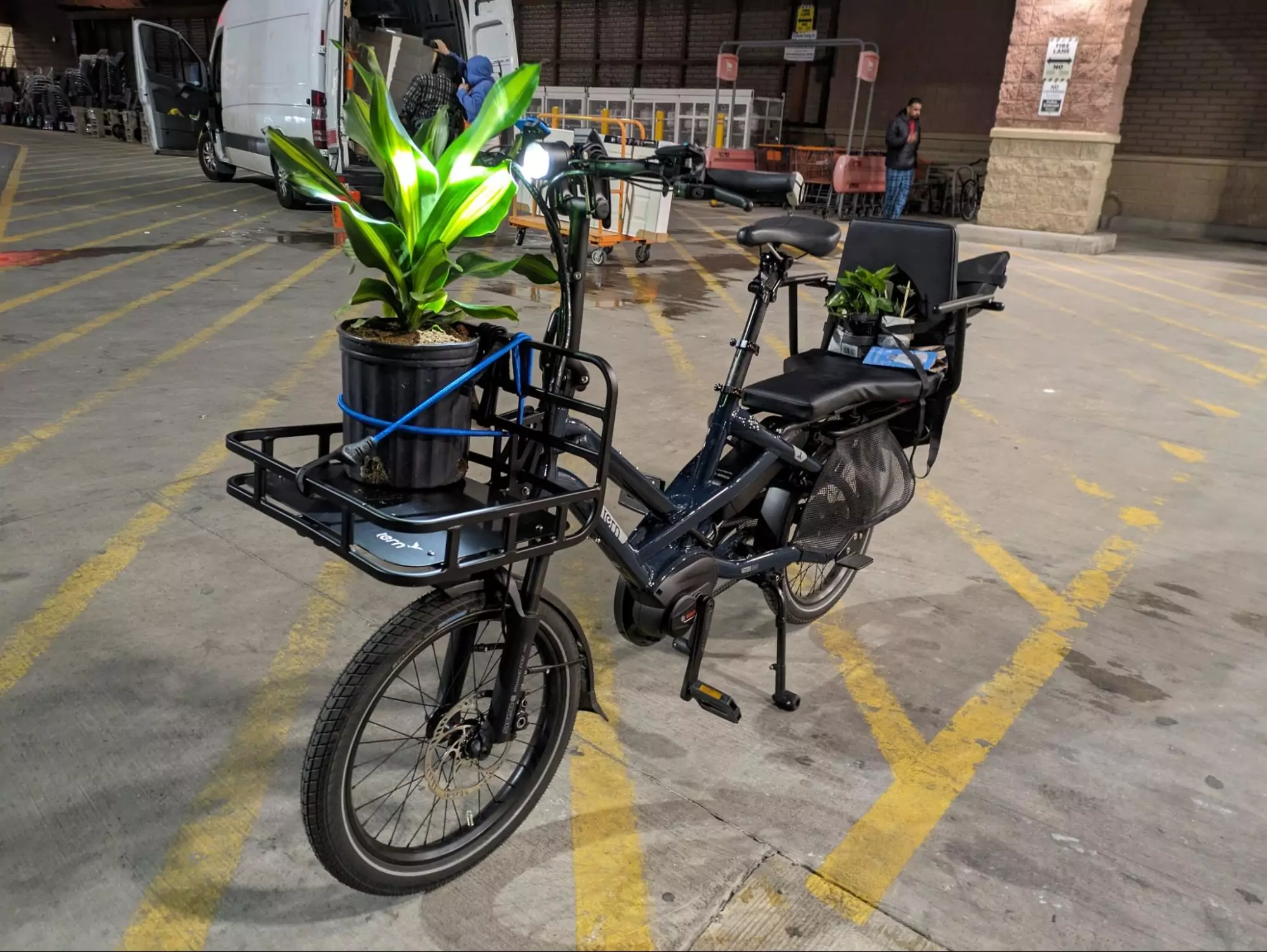
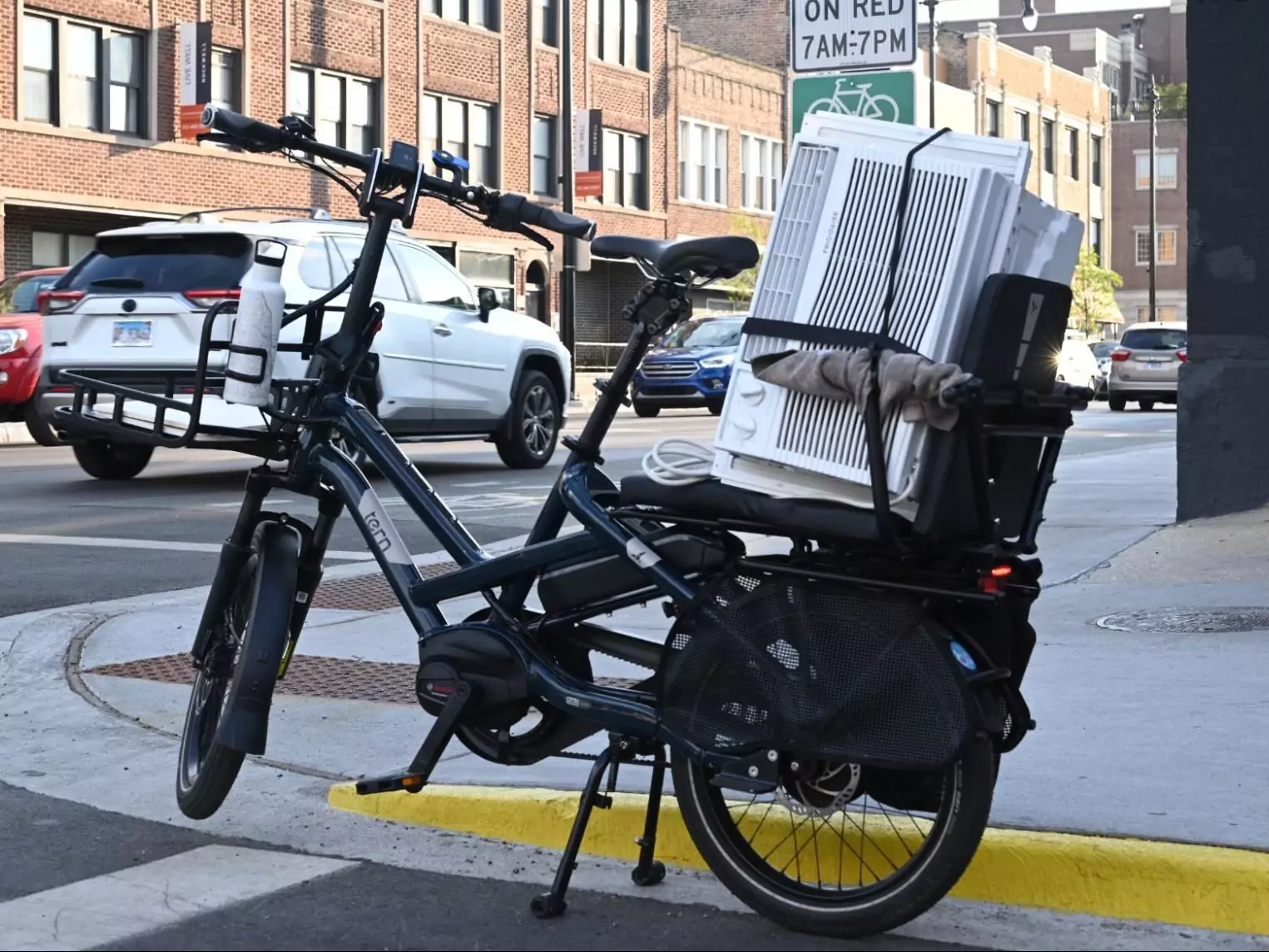
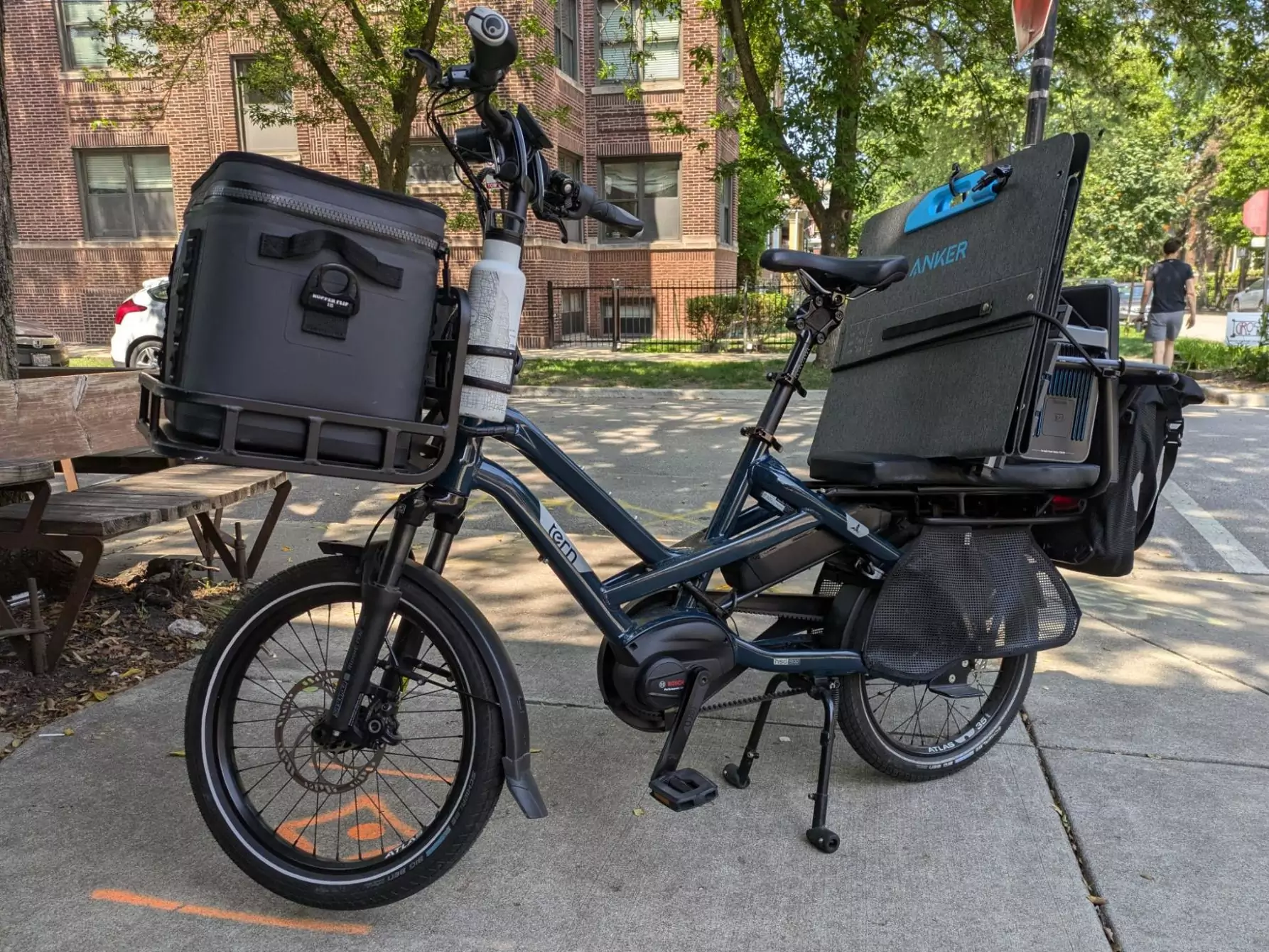
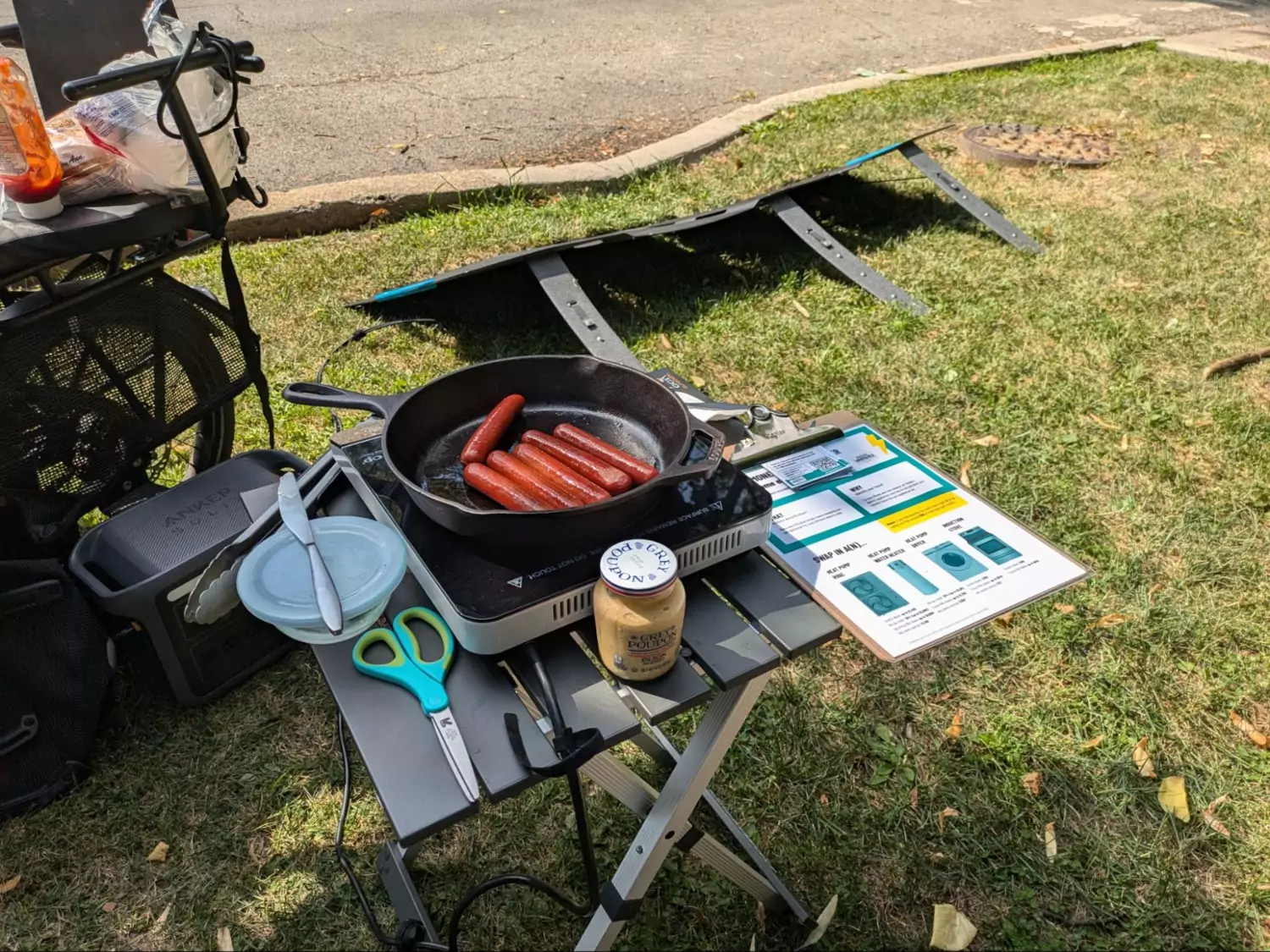
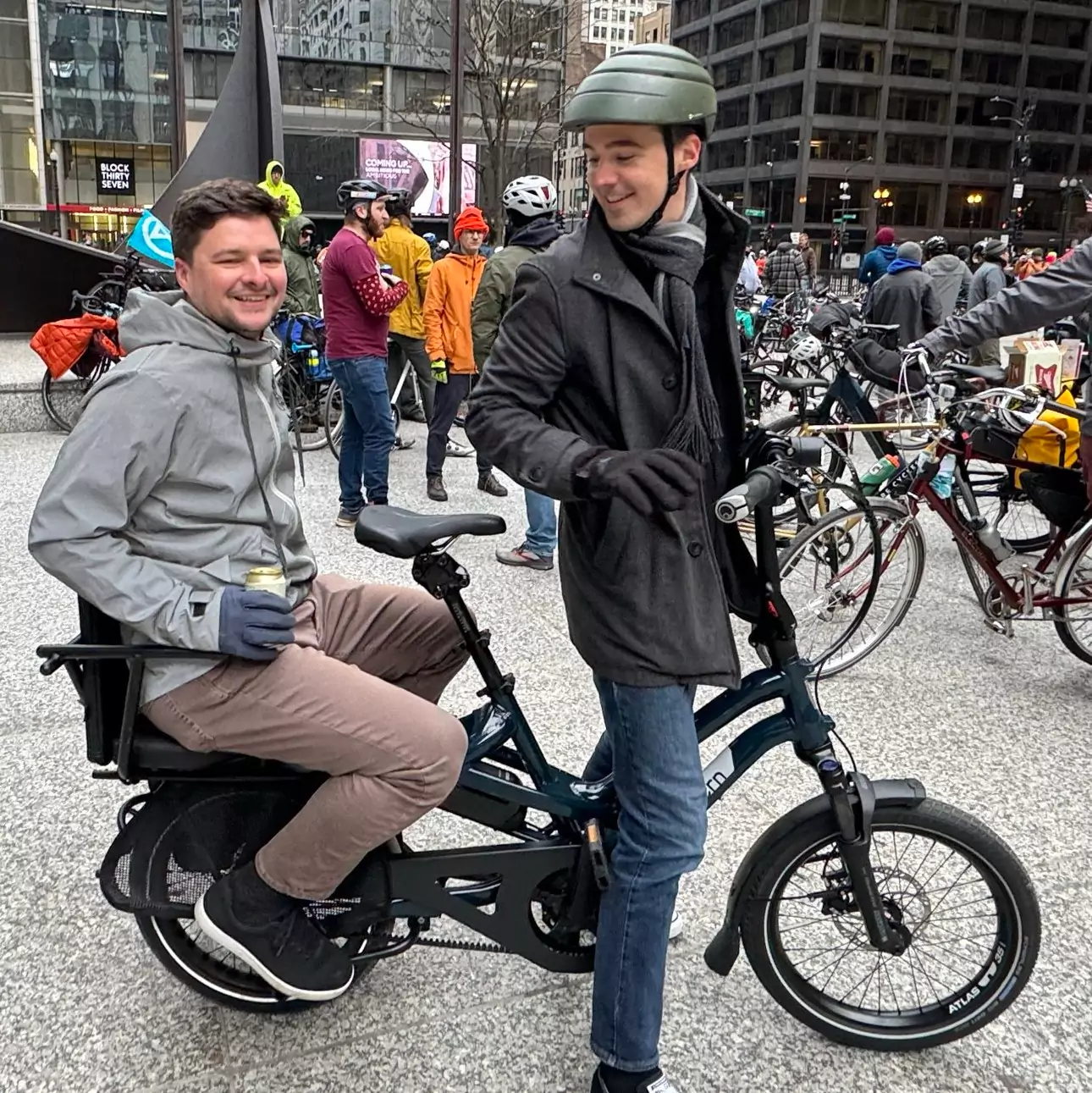
Incredibly Low Running Costs
I break down a more fair apples to apples comparison of owning an e-bike to owning a car, but I paid for my e-bike up front, so my running costs are charging it to full with about ten cents of electricity a few times a month, and paying $35 of insurance for two e-bikes. That means that most months I’m paying less for two e-bikes than for just two CTA 7-day passes ($20/ea), or parking downtown for two days (often $20 a day). Add in that in two years of owning my first e-bike, I’ve only had one out of pocket maintenance cost, and you’re looking at a truly affordable transportation option. And you never have to pay for parking - you just roll up to a bike rack, fence, or other secure structure, and lock up!
Easy Charging At Home Or On The Go
When considering switching from a gas to an electric car, it’s a lot easier to make the switch if have a garage to plug in, and even better if you can install a higher powered Level 2 charger. But with an e-bike, you’re dealing with a much smaller battery that can often be removable! That means that even if I’m locking my bike outside in a cafe, I can bring the battery inside and charge it. But like an electric car, most of my charging is at home, and I just plug it in. Since I store my e-bike in my oversized kitchen, that sometimes looks like plugging it in just behind the stove.
It’s worth noting that smaller e-bikes often don’t have a removable battery to save on weight (they can be integrated into frame of the bike itself), but every cargo e-bike I’ve seen has a removable battery to let you charge the battery off the bike or to let you swap batteries if you decide to buy a second one, but personally, I’d rather just bring the charger.
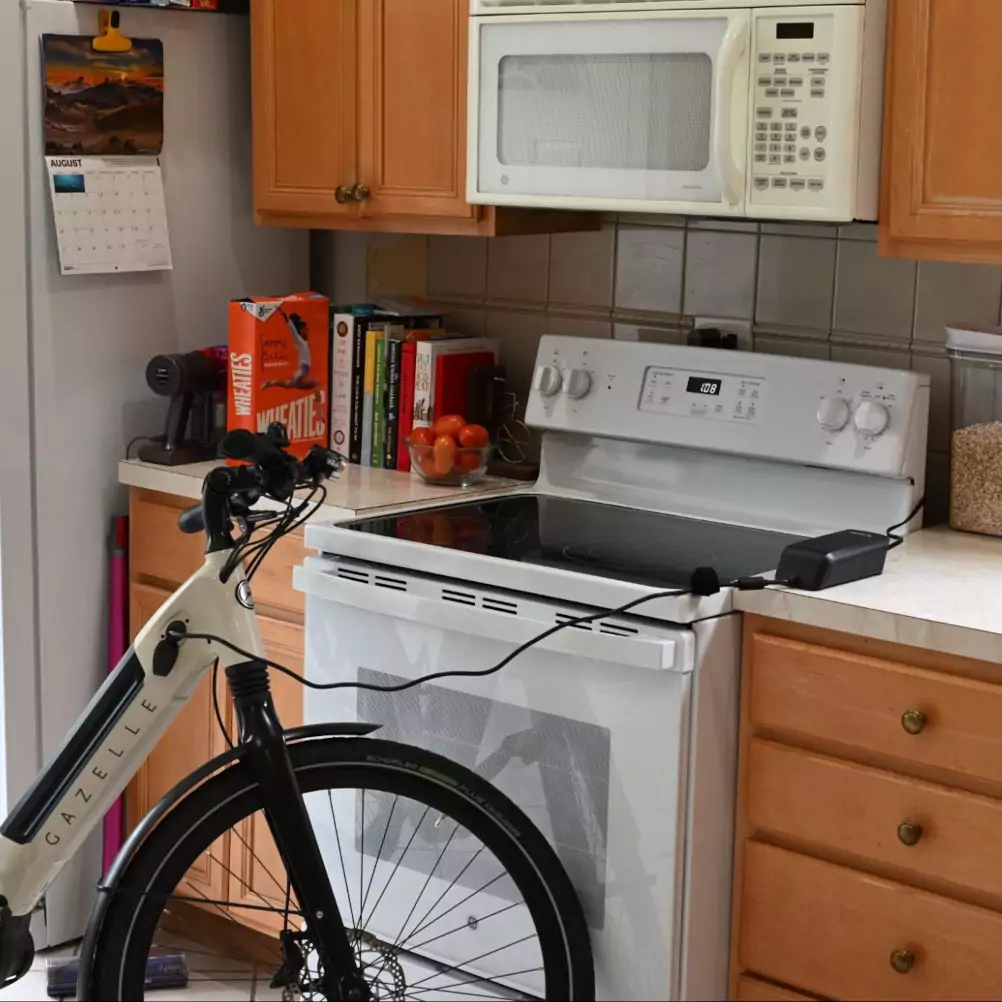
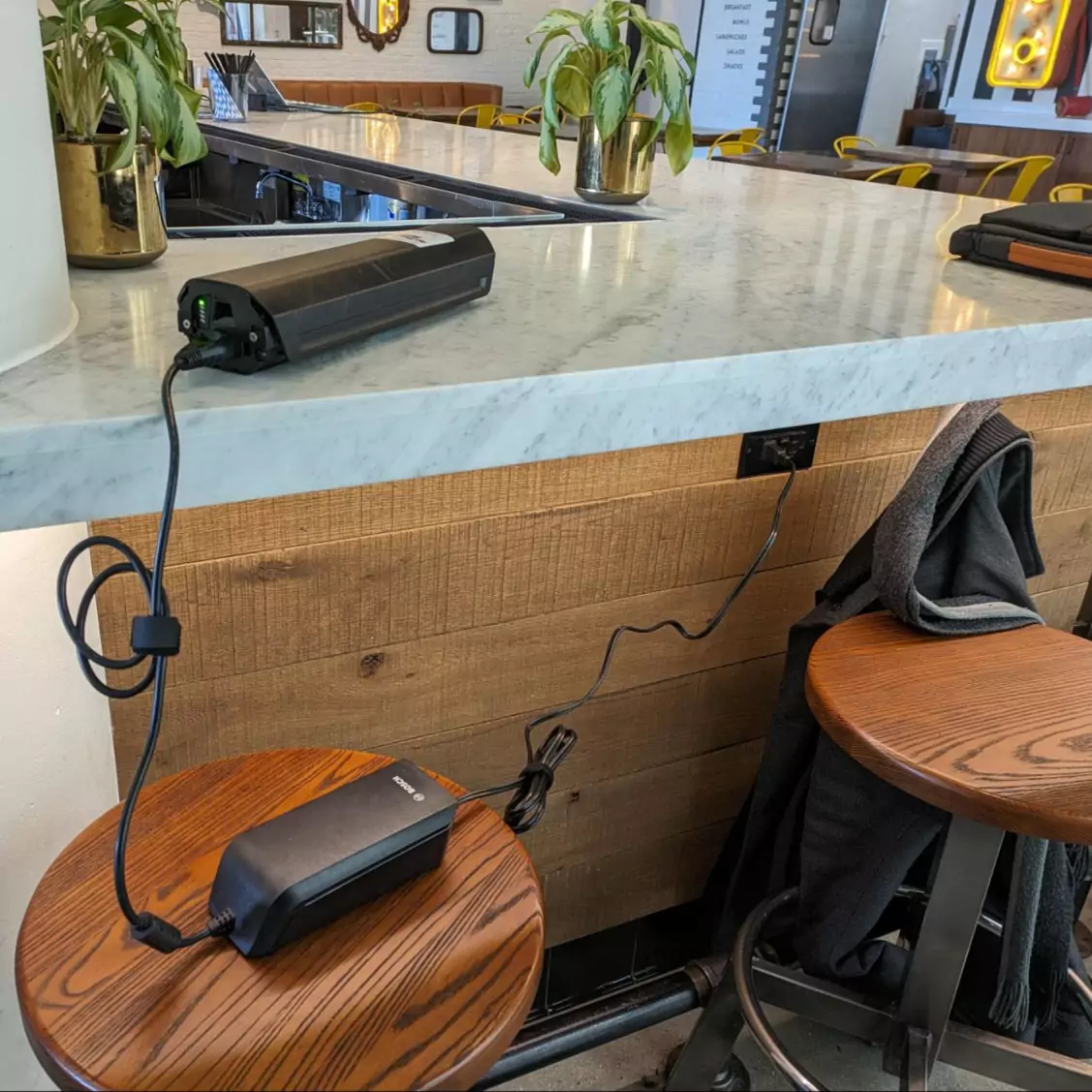
Charging my Gazelle e-bike in my kitchen by plugging it in, and charging it at a cafe by bringing the battery inside.
It’s Incredibly Low Emissions
My Tern has a 545 Wh (or 0.545 kWh, see Glossary) battery, and can travel, at worst (highest assist) 32 miles on a charge, giving it a rough efficiency of 58 miles / kWh. For comparison, the quite expensive Lucid Air made a big splash in the EV world in 2024 with a claimed 5 miles / kWh, a record in production cars, making my Tern HSD over 11 times more efficient than this premium electric car. To put it into more familiar terms, my Tern HSD conservatively gets the equivalent of a whopping 1,954 MPG! (based on this online calculator).
There’s also just the fundamental raw materials involved - an e-bike is heavy compared to a standard bike, and mine clocks in at just under 62 pounds without accessories. But if you compare that to the materials that go into a full size car, you can imagine the savings. A base 2024 Tesla Model 3 clocks in at 3,880 lbs (Tesla), 62 times as much as my Tern HSD. That’s 62 times as much mining, processing, and transporting of those materials. And with a 0.545 kWh battery compared to 60 kWh in the base Model 3, you could hypothetically make 110 Tern HSD batteries with the materials used for just a single Tesla Model 3. That’s a whole lot of e-bikes! If you’re someone who’s concerned about the environment, an e-bike can be an incredible option.
And, It’s Still A Bike!
I talk to a lot of folks who bike around Chicago, and if you’ve never biked for transportation, I’d really encourage it. You get outside, get some exercise (even on an e-bike) and often get to experience your community in a totally new way. When I go out on a bike, I smile and wave to my neighbors, can talk about my e-bike to folks stopped at a light, and at any point I can just stop and check out a cool mural, coffee shop, or anything else.
The Downsides of a Cargo E-Bike
I know that you’ve probably already been thinking about some potential reasons you might not want to get out on an e-bike - so let’s talk about some of them.
It’s Big and Heavy!
There’s really one big downside to a cargo e-bike: some can be quite big and heavy compared to a standard bike. For most folks, you might want a cargo e-bike like the Tern GSD or the Urban Arrow, but unlike a regular bike, you’re probably not going to be able to store this in your apartment. I got the Tern HSD because at 60 pounds it’s at the upper limit of what I can bring inside my second story apartment, but most folks I know with cargo bikes also have a garage they lock it in, or they park it heavily locked under a back porch with a motorcycle cover.
I’d point folks to a video from Cargo Bike Momma in NYC, who talks about parking a bike outside in New York City - if you can make it there, you can make it anywhere!
The Weather

Biking during some November snow. Jeans, a winter coat, and a scarf kept me warm!
Bike Safety
Lastly, safety is one of the most common concerns I hear about folks worried about picking up biking, and it’s an absolutely valid concern. In a car, you’re surrounded by a metal cage with crumple zones, air bags, and oftentimes even sensors that will try and automatically bring your car to a stop if it detects an upcoming collision. On a bike it’s just you and your bike, on the road.
For folks starting out, I’d encourage you to start slow, with local residential streets you know are low-traffic, as well as trails, and see if those can provide you with any of the connections you need. As you get more comfortable, you’ll learn what routes you like and what you’d rather avoid.
There’s also tools to help you find safe bike routes - Google Maps has a Bike layer that will show you protected bike lanes, and in Chicago there’s Mellow Bike Map, which can get you directions that stay on more calm residential streets.
And lastly, many cities, suburbs, and towns are improving their bike infrastructure, putting in protected bike lanes and off-street paths that keep folks biking safe from car traffic. In Chicago there’s been a lot of advocates pushing for this, but unfortunately it gets a lot of pushback from folks who feel cars should be the dominant priority of our roads. I hope even if you don’t decide to pick up a bike, you can see why protected and safe infrastructure is crucial to keeping folks safe when they ride, and encouraging more folks to ride, like this beautiful example:
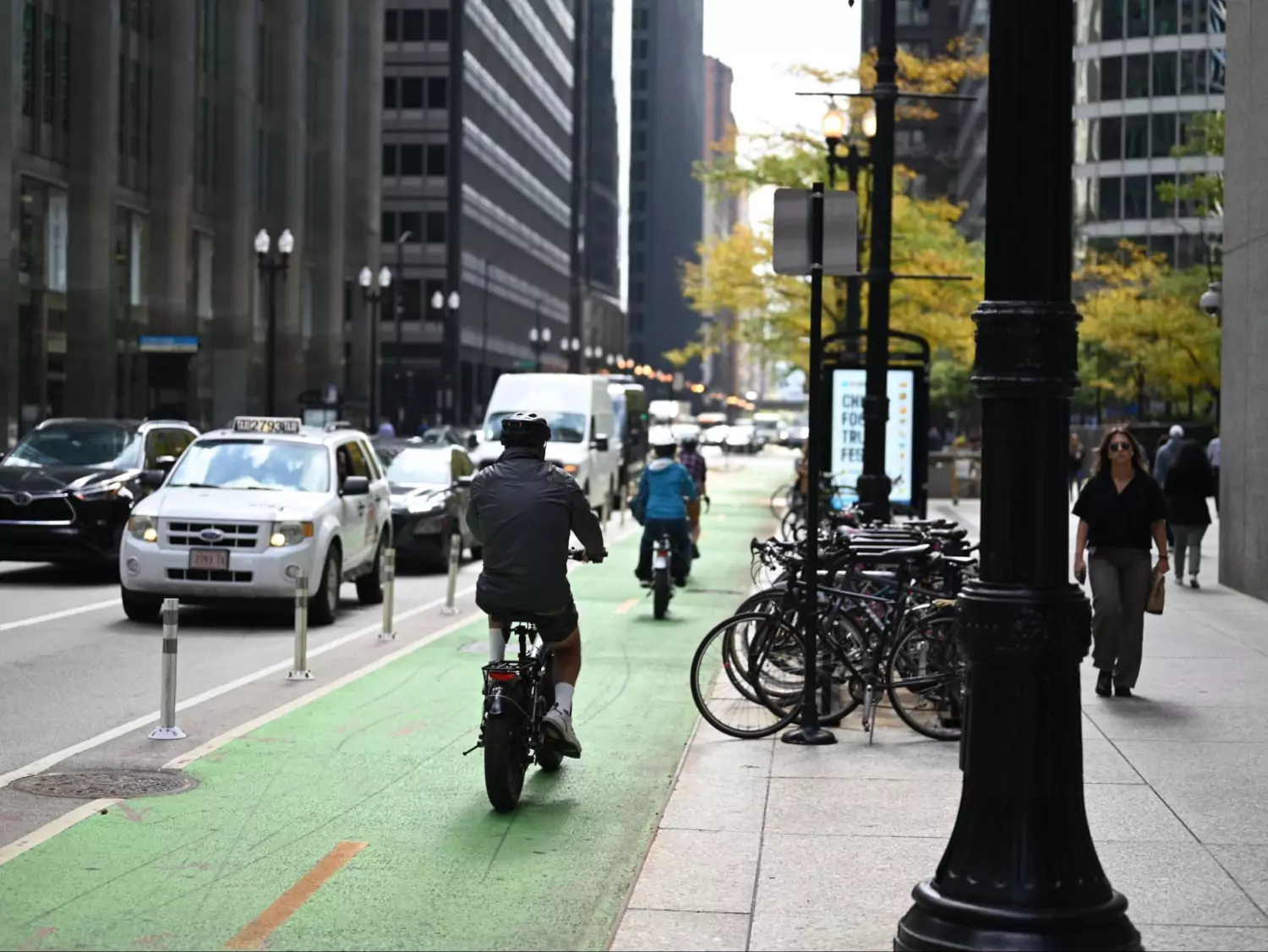
The Yearly Cost of An E-Bike - 10% Of A Car
We’ve talked about the pros and cons, but what does it cost to own an e-bike? As of writing, I’ve only had my Tern for about three months, so breaking down the costs wouldn’t make much sense. So instead, let’s break down the costs for owning and operating my commuter style Gazelle Ultimate T10 e-bike. I want to really make a direct comparison to a car, so instead of looking at the upfront cost and the really low operating costs, I’m going to break it down as if I financed my Gazelle, just like a car, to make it a really fair comparison.
Monthly Payment
As mentioned, I don’t have a monthly payment on my e-bike, because e-bikes usually are paid for upfront like a typical consumer purchase, rather than being financed, though some local bike shops are starting to offer one year financing plans. For the sake of comparison though, let’s pretend that I was paying the average six year car-loan term (according to NerdWallet). Since I bought a high quality e-bike that can be maintained at many local shops, it’s realistic to think it’ll last that long, but hopefully much longer.
The bike cost $4,408.90, so if we go for the average new car APR of 7.1% (July 2024, NerdWallet), we’re looking at a monthly payment of $75.17, based on the Nerdwallet Auto Loan Calculator, and that’s with $0 down payment.
Fuel Costs (Electricity)
I’ve gone 2,300 miles on my Gazelle, and at its worst (highest assist level) it’s rated to go 30 miles on a full charge of its 500 wH (0.5 kWh battery). That means I’ve charged it, very conservatively 77 times, and consumed about 38.5 kWh of energy. At a utility rate of $0.16 / kWh according toI EnergySage, that means I spent… $6.16 on fuel in two years, less than the cost of two gallons of gas in Chicago! Since I often run my bike in the lowest or medium assist setting, it’s incredibly even less than that, but we’ll stick with a conservative estimate.
Maintenance
I’ve had my bike for over two years and it’s been fairly trouble free - I had an issue with my chain at one point, but it was actually an issue with the chain that came from the manufacturer that was covered under the warranty. About one year in, I had a full tune up done, which includes the bikes mechanical and electronic systems, and that cost me $227. That definitely felt pricey, but it included a new chain and makes sure that my bike is ready to keep serving me for thousands more miles to come.
That means I had a total maintenance cost of $227 over two years of ownership.
Insurance
It turns out, insuring even a nice e-bike is pretty cheap compared to a car! My insurance covers the full purchase price of the bike in case of theft or covers repairs in case of an accident, and it cost me only $18.17 a month with just my Gazelle, with a $31.50 up front payment, coming out to $231 for a year.
Car Equivalent Annual Cost Breakdown
With all that broken down, let’s total it all up, and break everything down to an annual cost.
| Line Item | Cost Calculation | Annual Cost |
|---|---|---|
| 🚲 Eq. “Monthly Payment” | $75.17 x 12 | $902.40 |
| 🏦 Insurance | $231.37 | $231.37 |
| 🔧 Maintenance | $227 / 2 | $113.50 |
| ⚡ Fuel | $6.16 / 2 | $3.08 |
| Annual Total |
$1,250.35 $104.19 / mo |
|
Now keep in mind that although this is for my commuter style Gazelle e-bike, which was cheaper than my Tern HSD cargo bike, there are tons of cargo e-bikes available under that $4k price point. I also never made monthly payments with interest. And do you know anyone who is spending less than $1,250 annually on their car? The average American car owner is paying $1,765 annually just on car insurance, according to a Nerdwallet article on car insurance rates - that’s 40% more than my equivalent total annual cost of ownership!
Actual Annual Cost Breakdown
Although that previous figure is a good comparison to show off one-to-one how affordable even a cargo e-bike can be compared to a car, but I also wanted to show what my real world numbers look like.
First, the upfront e-bike purchase was $4,408.90. Then my running costs:
| Line Item | Cost Calculation | Annual Cost |
|---|---|---|
| 🏦 Insurance | $231.37 | $231.37 |
| 🔧 Maintenance | $227 / 2 | $113.50 |
| ⚡ Fuel | $6.16 / 2 | $3.08 |
| Annual Total |
$347.95 $28.99 / mo |
|
At less than $29 a month, that makes my e-bike is some truly affordable transportation!
Living Without A Car
But Without A Car, How Do You Do _? (Road Trips, Move Bricks) Rent The Car You Need!
I’m fortunate to live in a walkable neighborhood where I am within a fifteen minute walk or bike ride of multiple grocery stores, coffee shops, bars, and cafes, and have access to transit to get me to work and medical appointments further away. But sometimes I truly need a car, like if I’m trying to go from Chicago to Cincinatti, where Amtrak offers only three departures a week. In a situation like that, I rent a car for the time I need. And if I need to move a bunch of stuff, I can rent a moving van specific to the task.
Are car rentals expensive? Sure, a few hundred dollars to access a car for a few days might seem like a lot, but you have to think about how much you save by not owning a car throughout the year. In 2024 I’d encourage looking at this great New York Times article breaking down real costs of car ownership, although it’s from October 2023, it shows that most of the folks they interview spent over $10,000 annually for their cars. That’s a lot of car rentals!
And if not owning a car isn’t practical, some households have gone from owning two cars to having one car and a cargo e-bike (so they can save all the costs of maintaining one car but still get access to a car when they really need it) or you could keep your car but use a cargo e-bike as a supplement - reducing the wear and tear you put on your car, money spent on gas, and potentially letting you opt into a cheaper low-mileage insurance plan. Those savings alone could well offset the cost of an e-bike!
An E-Bike Won’t Do, I Need A Car, Right Now! Used EVs Might Be Your Solution
I get it, if you live in a more car-dependent area or need to travel long distances frequently, you might still need a car, and maybe your old car just went kaput and an e-bike just isn’t in the cards. I’m a big fan of electric cars, which, like an e-bike, have lower maintenance and fuel costs than a gas car. But, in 2024, new electric cars still come at a price premium with comparable gas vehicles (though make sure to check your federal and local incentives).
However, there are now some amazing deals on used EVs, like Chevy Bolts with 250 miles range at around $16 or $17k, or Tesla Model 3 long ranges with 310 miles of range for around $30k. Especially if you and the vehicle are eligible for any incentives (like the federal used EV tax credit) this can end up being either the same cost or less than an equivalent gas cars. I’d recommend this video for some starting recommendations, and you can search on many used car sites, like Edmunds, for just EVs, and filter by the range you need.
And if you think an EV can’t work for you, I’d encourage you to really look at the charging options near you (PlugShare is a great resource for that) and look at your daily and weekly driving. Even if you can’t charge at home, there are lots of folks in major metros who charge weekly or every other week, because you’re probably not emptying your car’s battery all that often.
Cargo E-Bikes Offer 80% Of the Value of A Car, At 10% The Cost
Often when I talk about bikes and even cargo e-bikes, people immediately jump to what my bike can’t do. And are there things even my cargo e-bike can’t do? Absolutely! But the real question is whether the cost of owning a car is worth it to you when you have a vehicle that can do most of the same tasks. If you live in a rural area where it’s 10 miles to the nearest grocery store, you definitely need a car, but Americans increasingly live in urban or suburban areas, where even if your nearest shop isn’t within a fifteen minute walk, it’s probably within a fifteen minute bike ride, and a cargo e-bike makes those journeys extremely doable.
If I need to move a bunch of heavy stuff, I might need a car, van or truck, but the cost of an e-bike plus renting a car a few times a year is much much less than the cost of me owning my own vehicle. So I’d really encourage anyone looking at getting a new vehicle to test ride an e-bike, and see if this cheaper, greener, and easier option can fill some or all of your transportation needs.
And if you want some inspiration from tons of different folks who already use bikes (including several cargo e-bike folks) to get around my hometown of Chicago, check out my photo project, Chicagoans Who Bike.
Interested? Some Cargo Bike Options & Buying Notes
I really like this guide from Cargo Bike Life, which shows off the whole range of different cargo bikes, from smaller options with front racks to trikes that can carry over 200 pounds!
Before you pick a cargo bike, I’d really encourage you think about:
-
How much you’re willing to spend
-
What you’re primarily going to be transporting (adults, kids, cargo?)
-
Any limitations on storing your bike
-
Where you’ll be getting maintenance and support for your bike
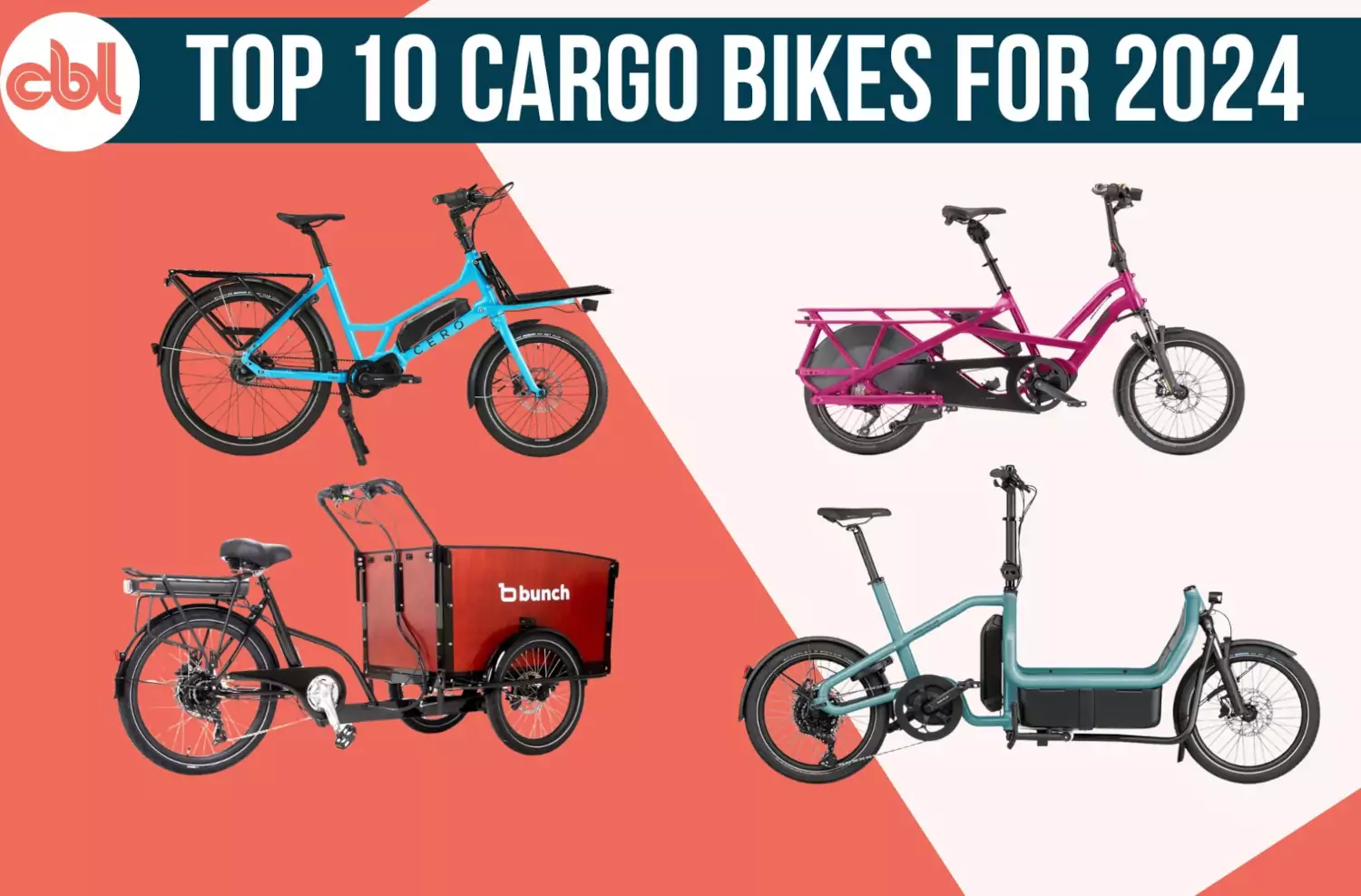
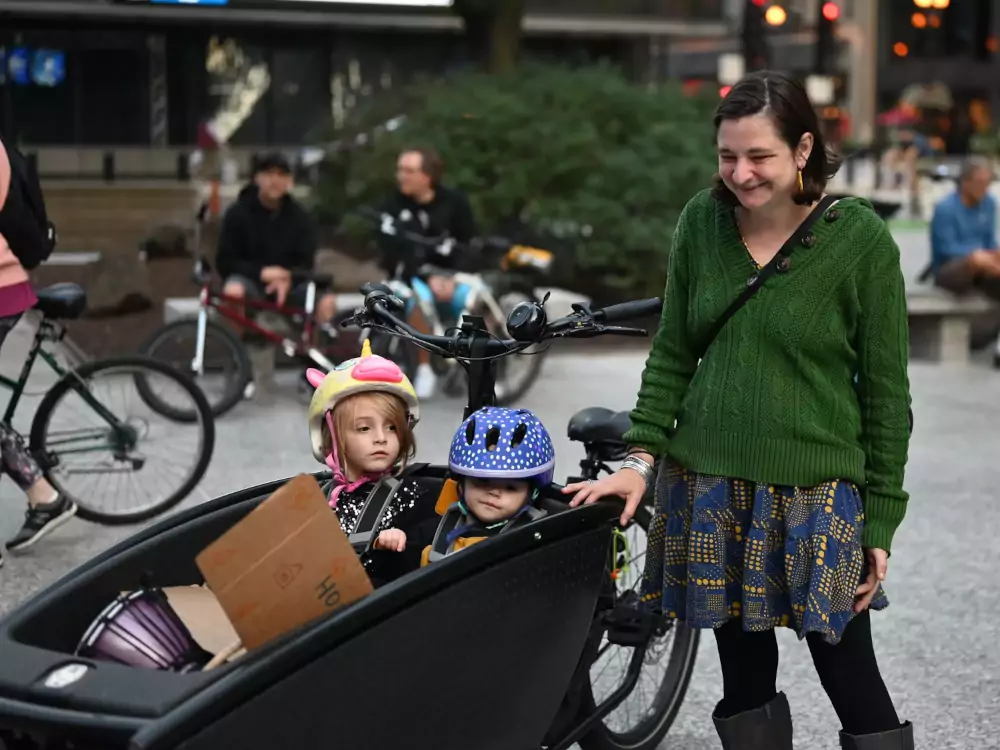
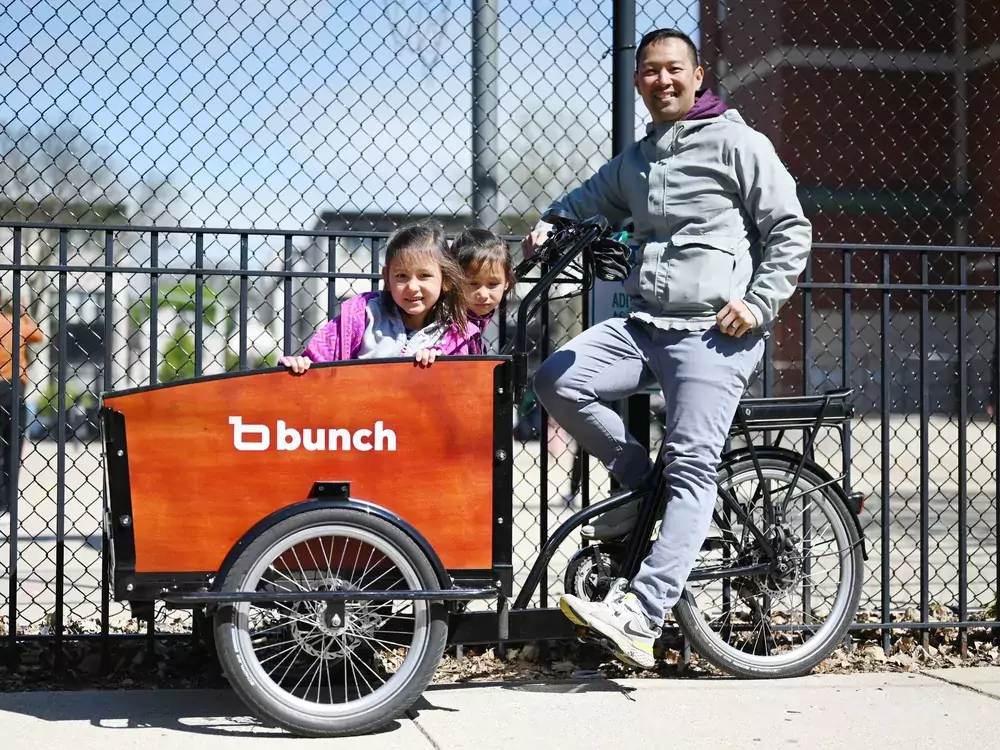
Photo 1: Look at all those e-bikes! Credit to Cargo Bike Life.
Photo 2: A mom and her kids in an Urban Arrow e-cargo bike, ChiWhoBike #15.
Photo 3: A dad and his two kids in a Bunch e-trike, ChiWhoBike #52.
Although online only options can be a lot cheaper, I prefer to purchase an e-bike from a local bike shop who can access parts and support from the manufacturer without shipping a heavy bike back to them. I want to know that I have someone I can go to if I’m having any issues, just like you might value having a local dealership with a car who can handle repairs.
And make sure you budget for a good lock - since an e-cargo bike is more valuable, it’s a big target. There’s a [good article on locks from Bunch Bikes</a>https://bunchbike.com/blogs/the-bunch-blog/how-should-i-lock-up-my-bike), but a good rule of thumb is to allocate about 10% of the value of the bike on a lock.
Lastly, like a car, you should get insurance for your bike! Some homeowner’s or renter’s insurance policies may cover your bike getting stolen if it’s stored at home, but you should see if it covers your bike being stolen when it’s out and about. See this article from Treehugger on bike insurance for some suggestions.
Glossary
Watt Hour or wH - a unit of energy, equivalent to using one Watt for one hour. A single watt hour would be equivalent to running a 10 Watt LED lightbulb for 6 minutes (0.1 hour).
Kilowatt Hour or kWh - 1,000 watt hours. This is the unit of energy you’ll typically see on your electricity bill, and for context is roughly equivalent to running a microwave for an hour (1,000 W), about 10 hours of TV (at 100 W), or running a single 10 W LED lightbulb for 100 hours.
Ebike - short for electric bike, a bicycle with some sort of electric assist. These are distinct from e-mopeds or e-motorycles because they are fundamentally bicycles - even if it might be so heavy that it’s impractical, the pedals must be connected to the wheels, so you could operate it even if the battery totally runs out.
There’s also specific legal classifications for different speeds of e-bikes, see bikexchange article on US e-bike classes.
Pedal assist - a type of e-bike that senses how hard you are pedaling and provides output from the motor to match the effort you put in. If you stop pedaling, the motor stops working, and if you pedal faster, the motor works harder, making it a very intuitive experience. By contrast, some e-bikes are throttle assist, where there’s a throttle you can use to activate the motor without pedaling.